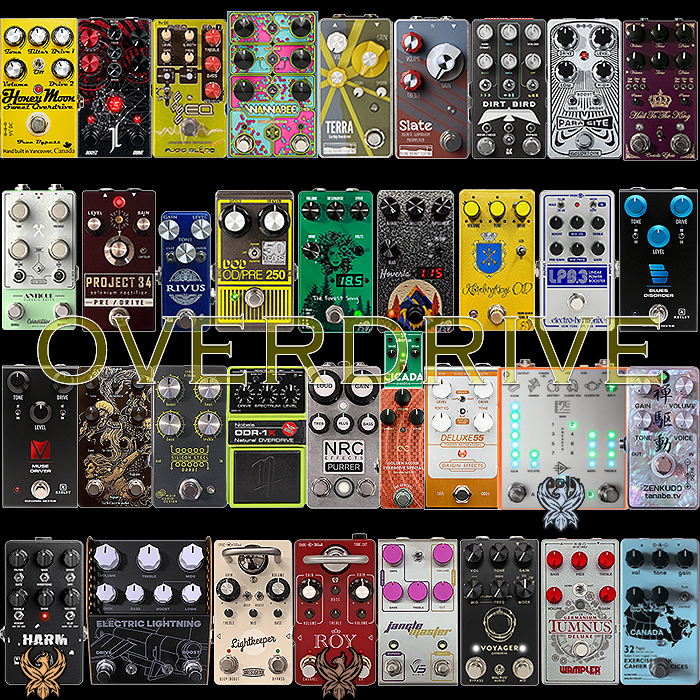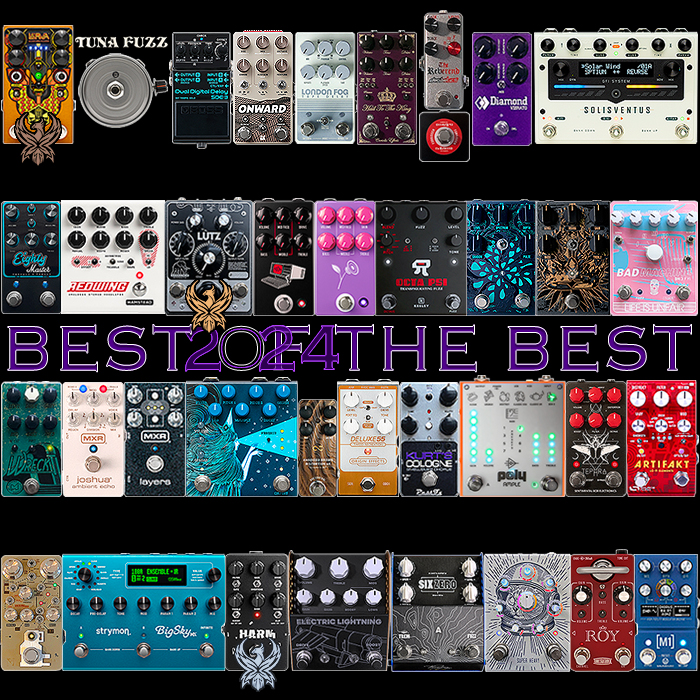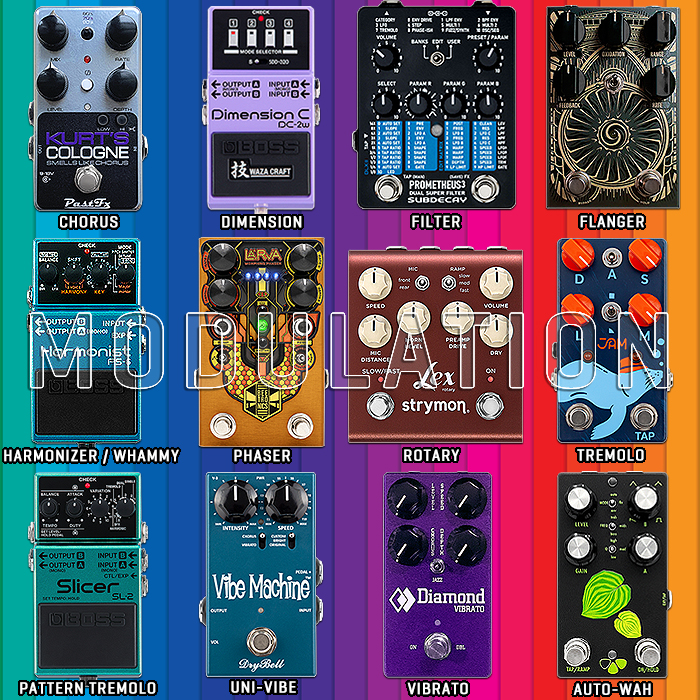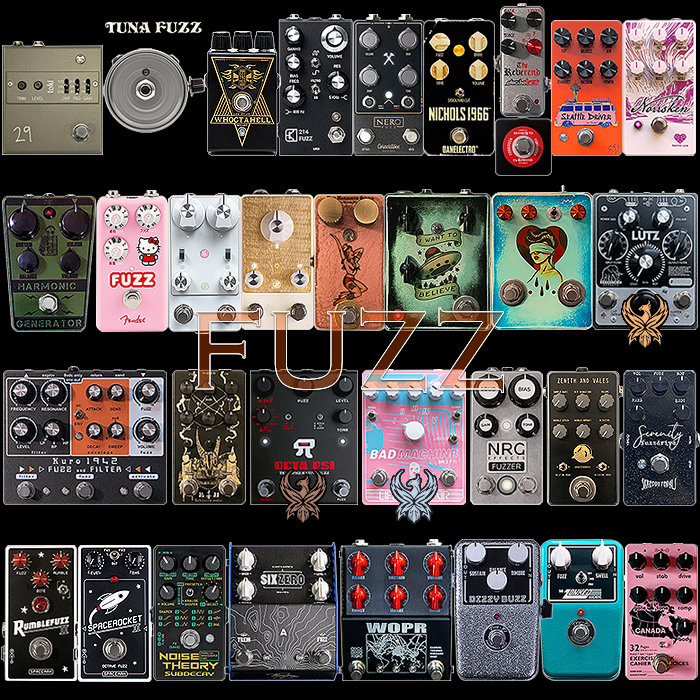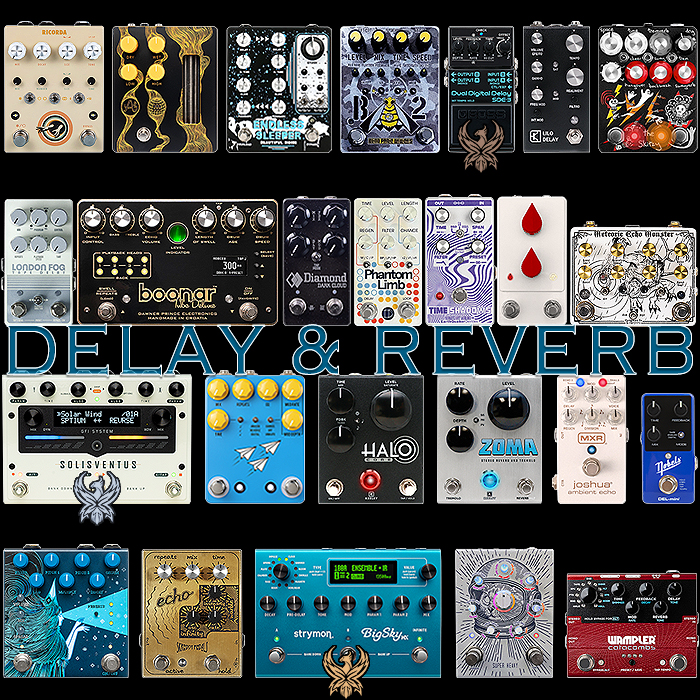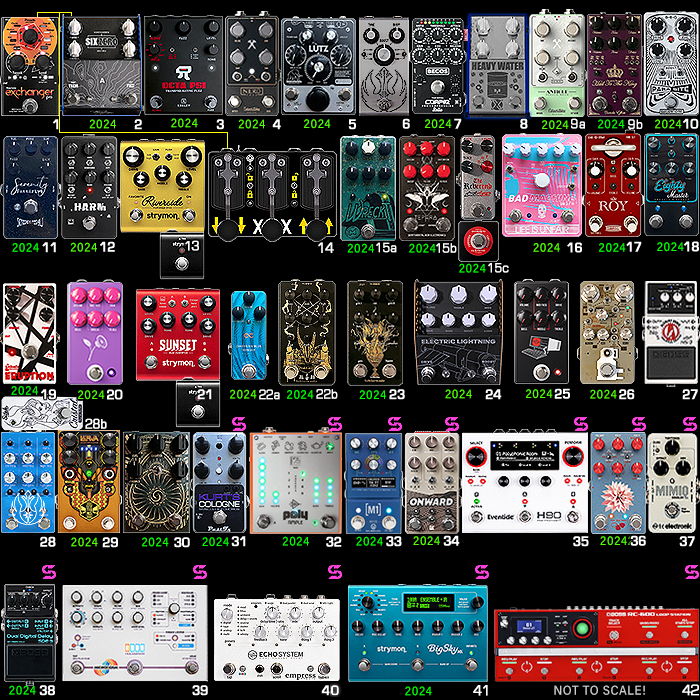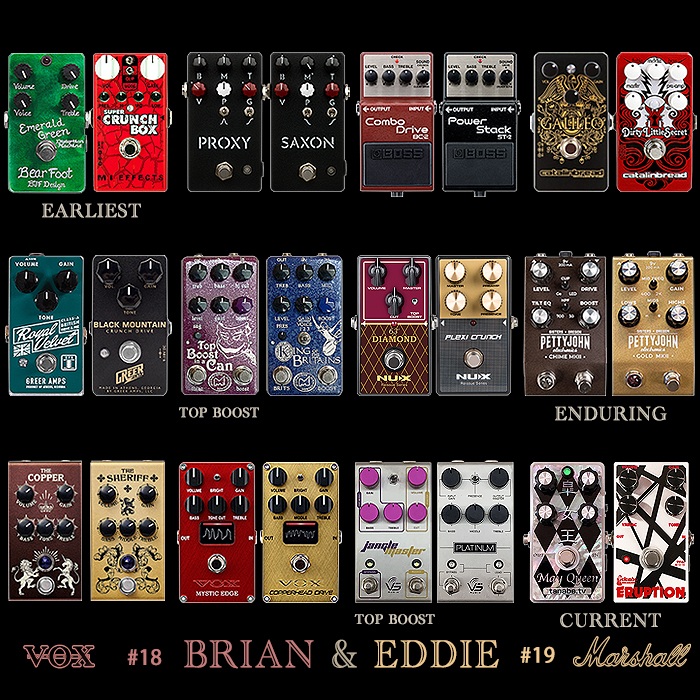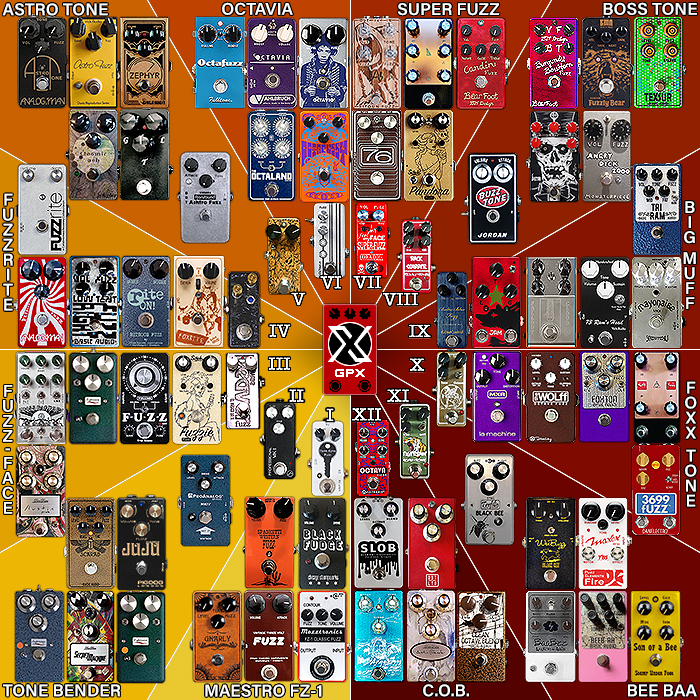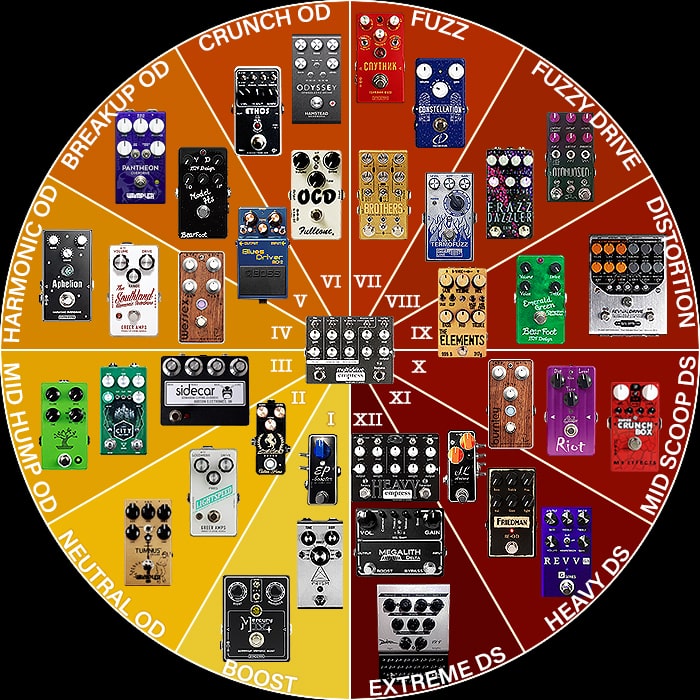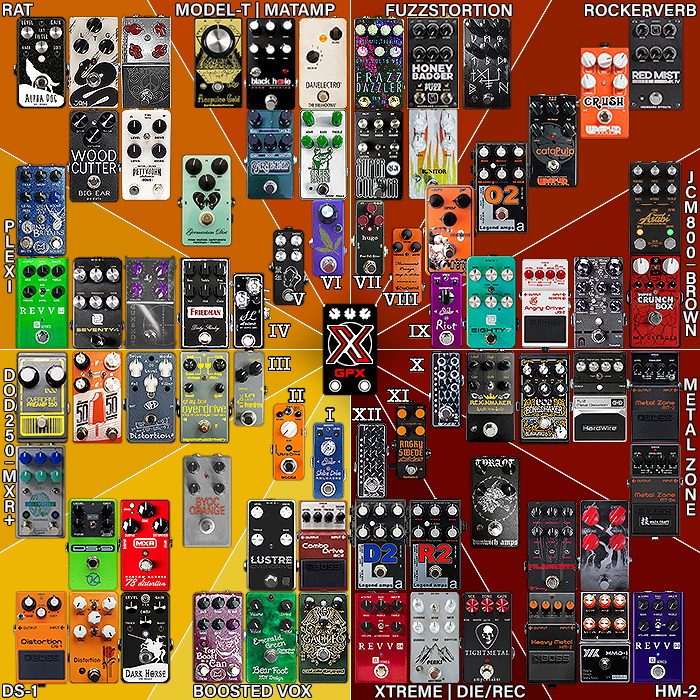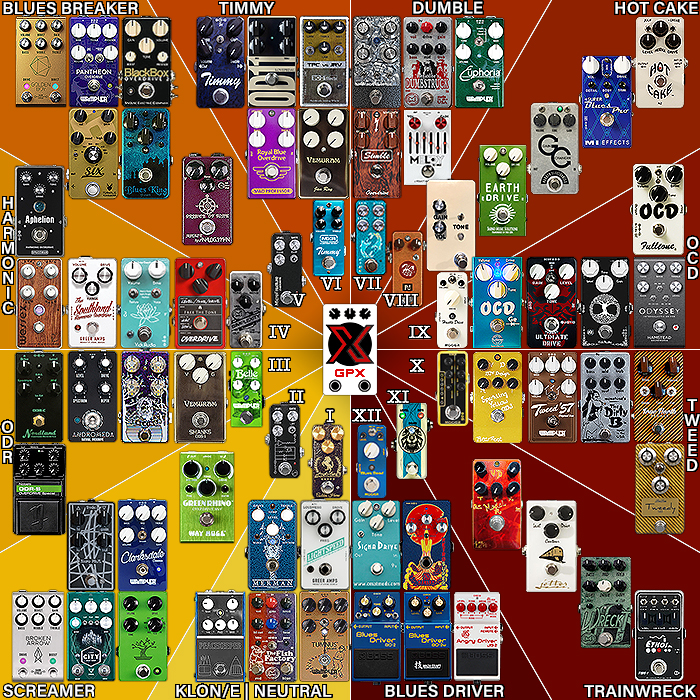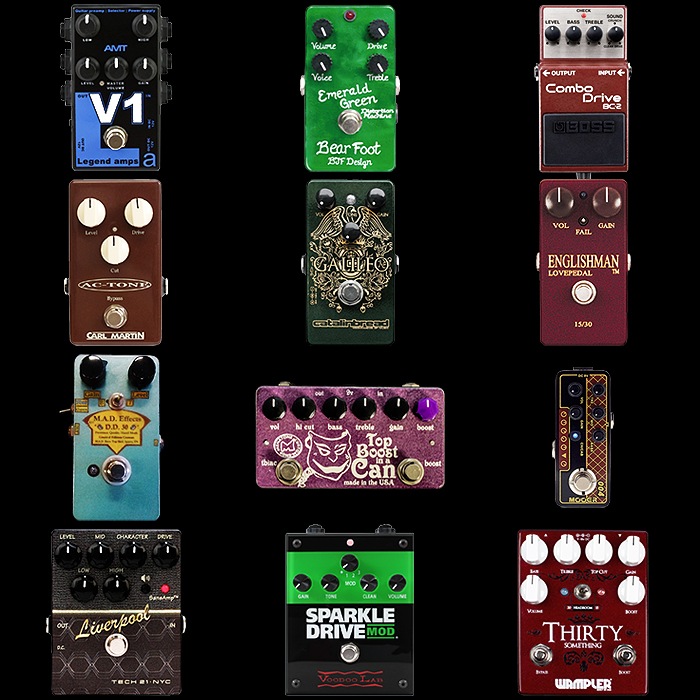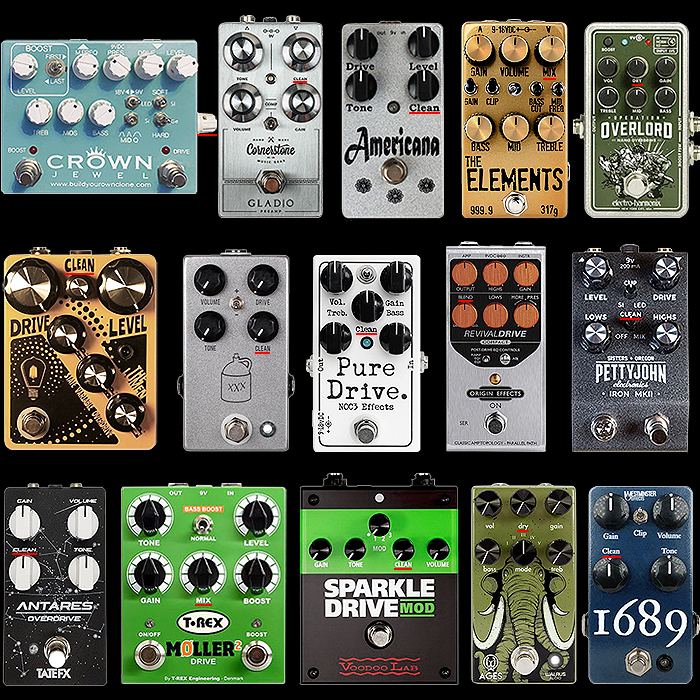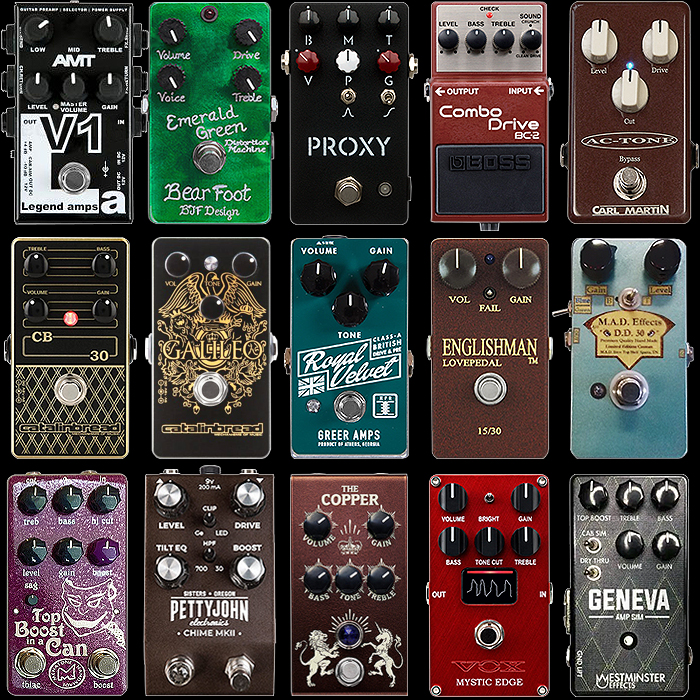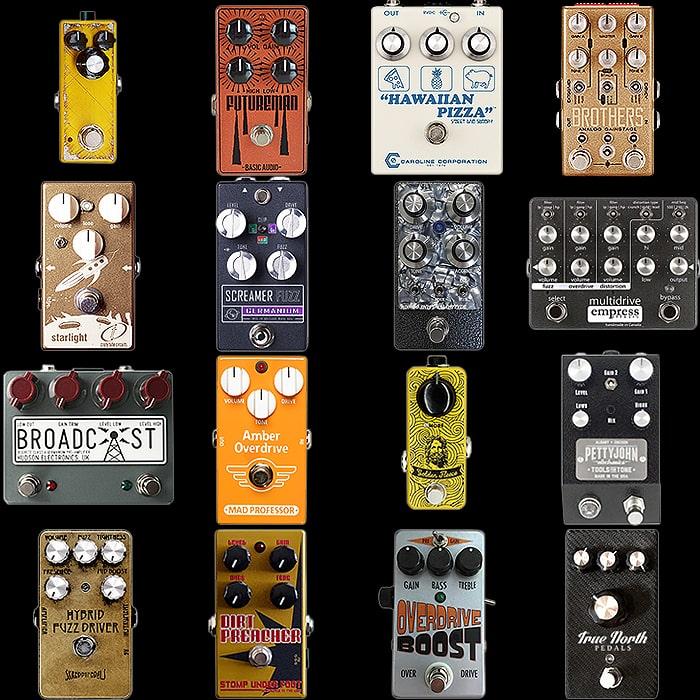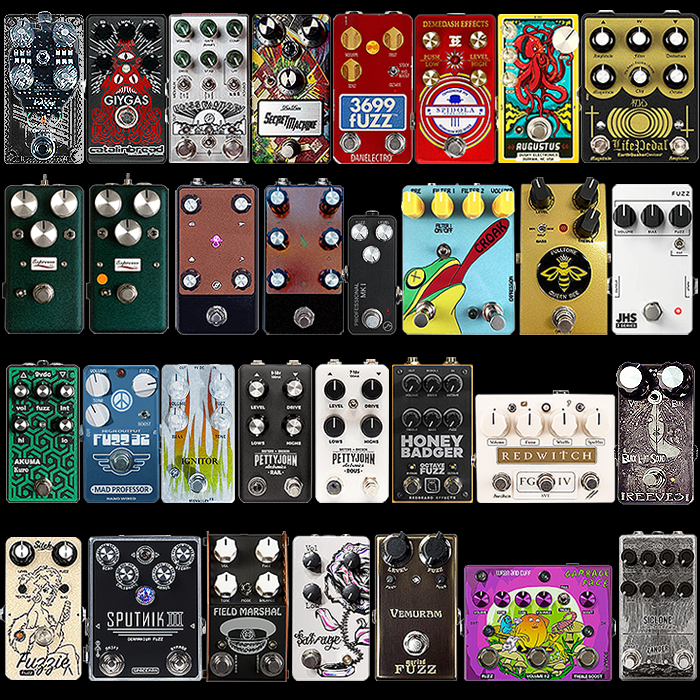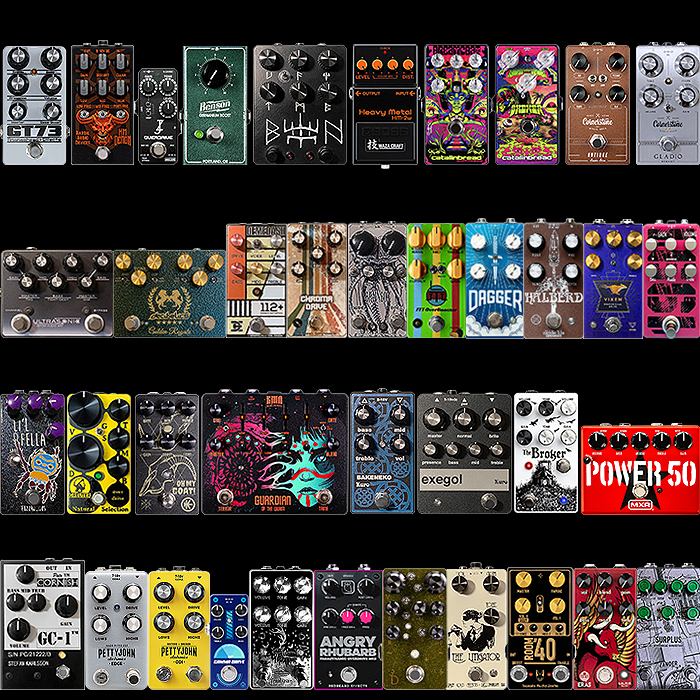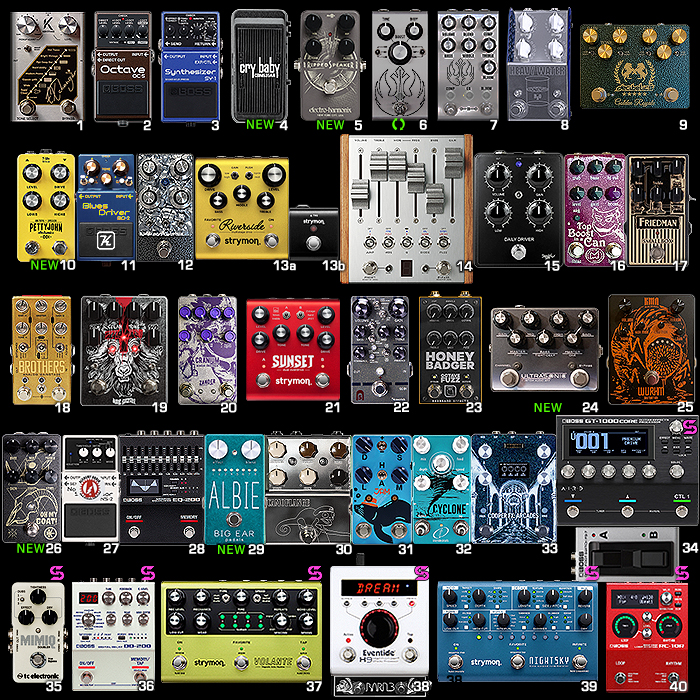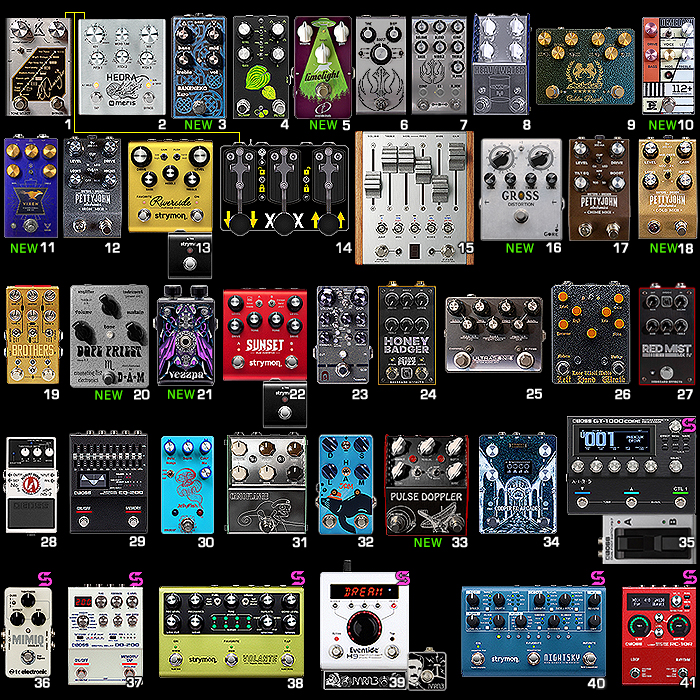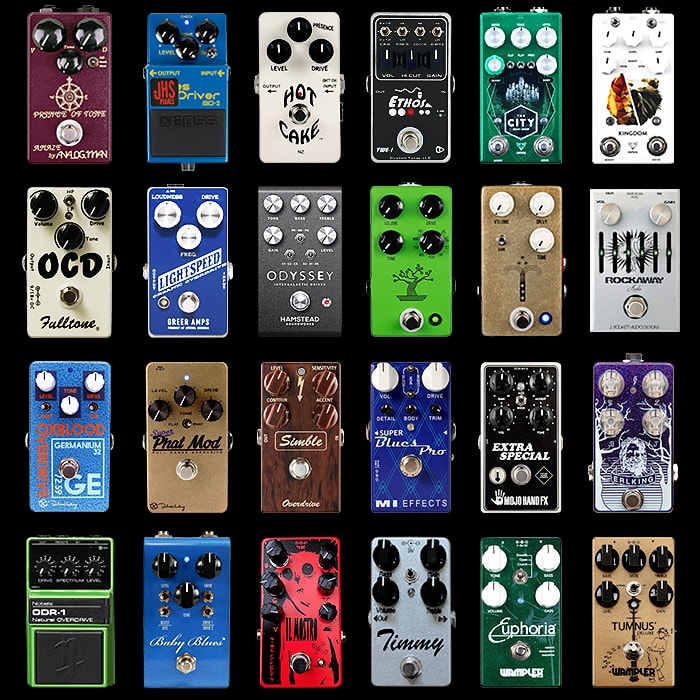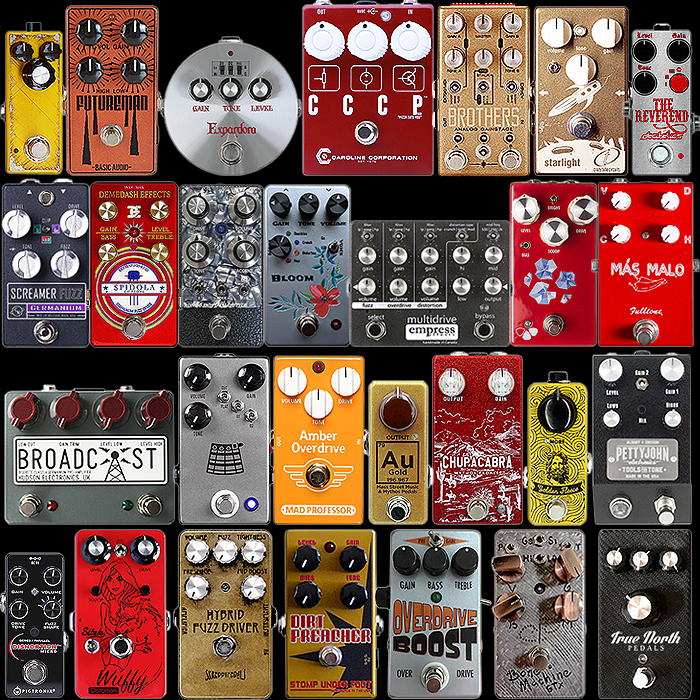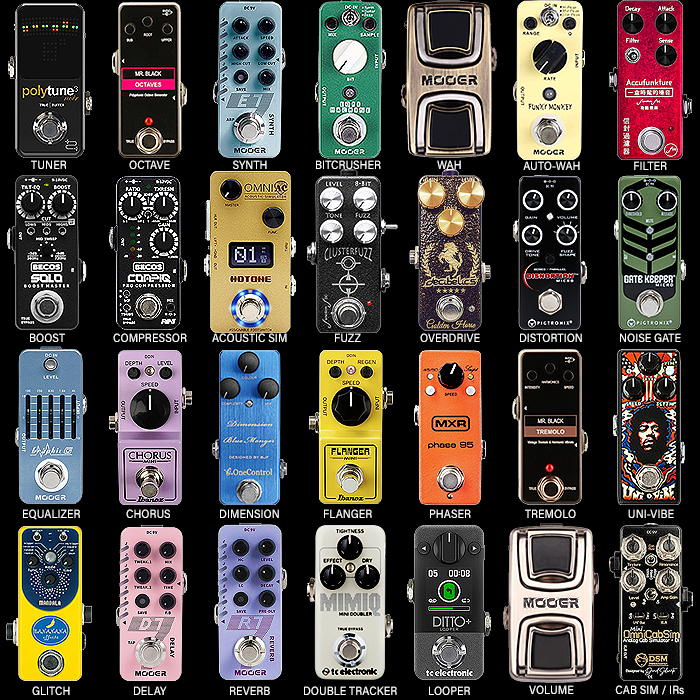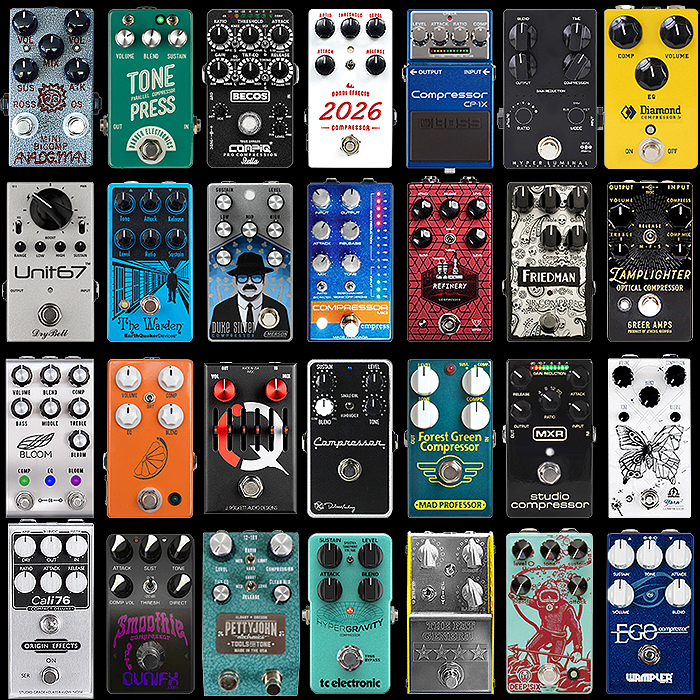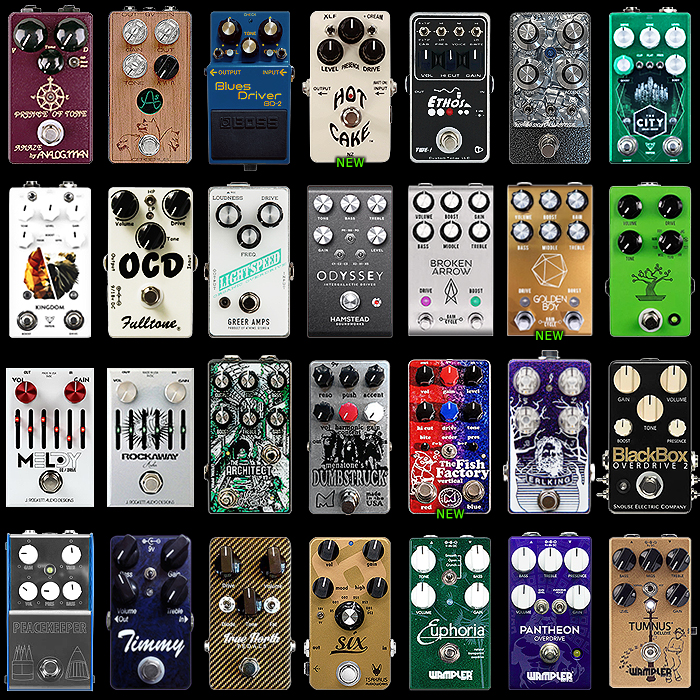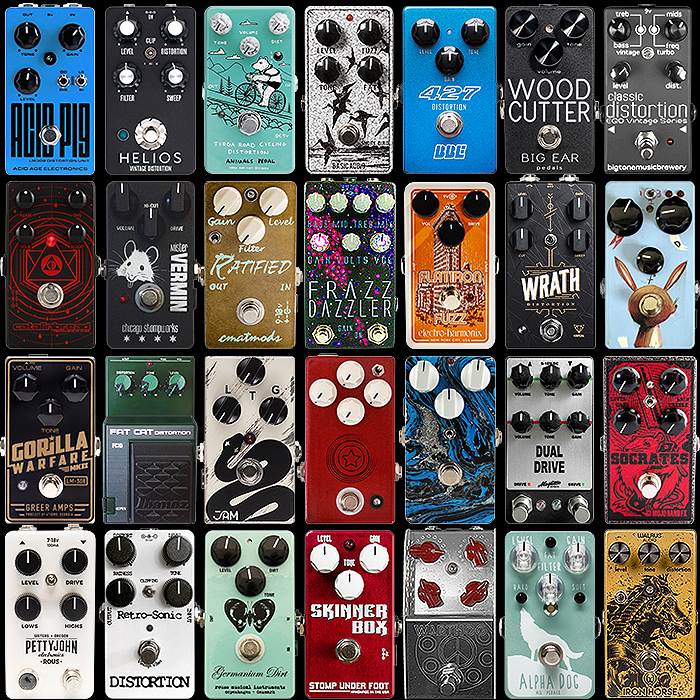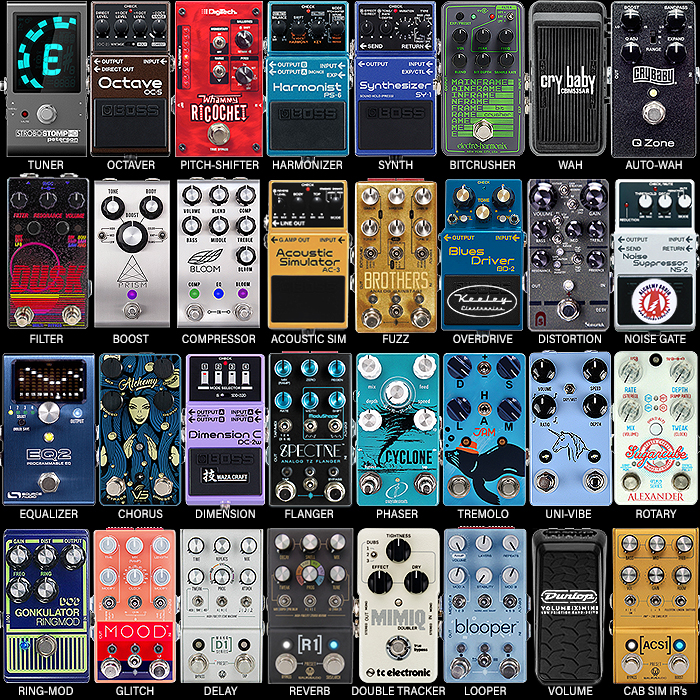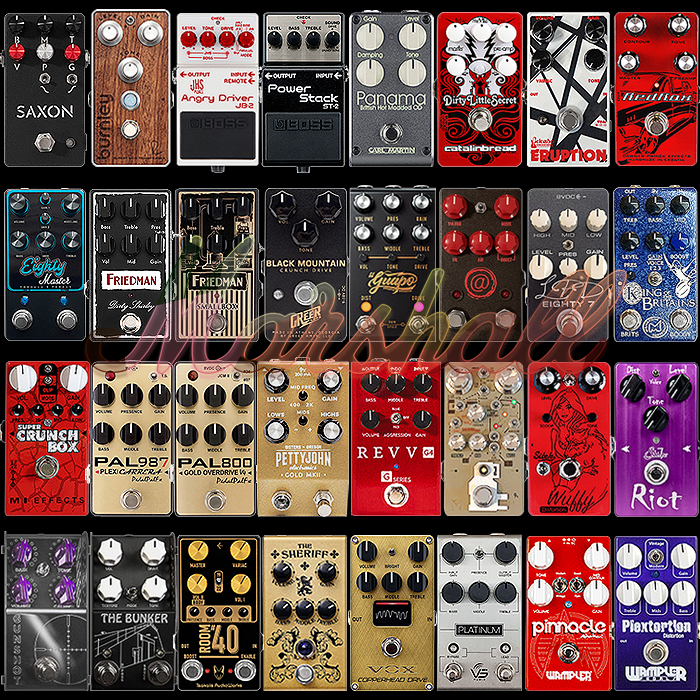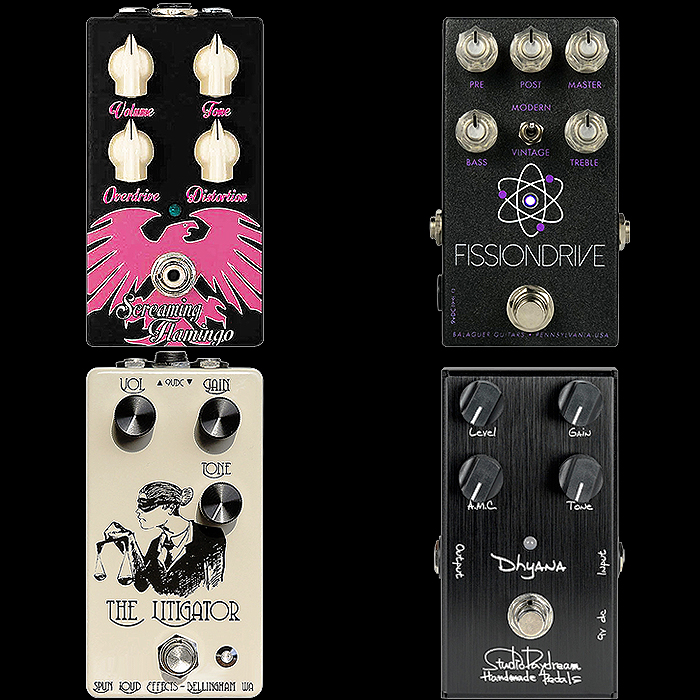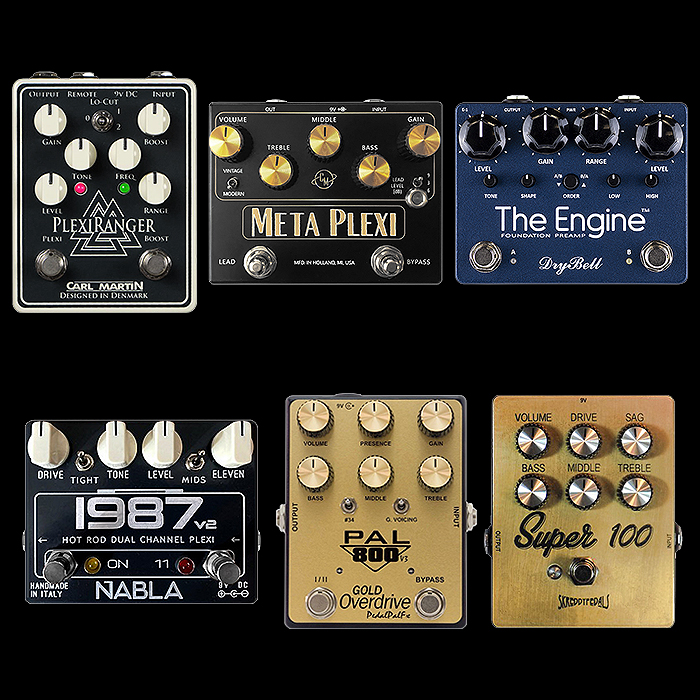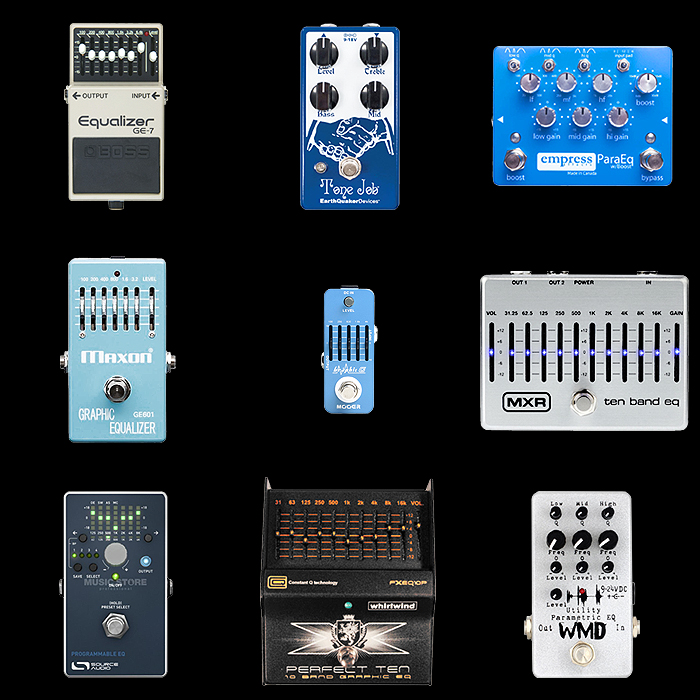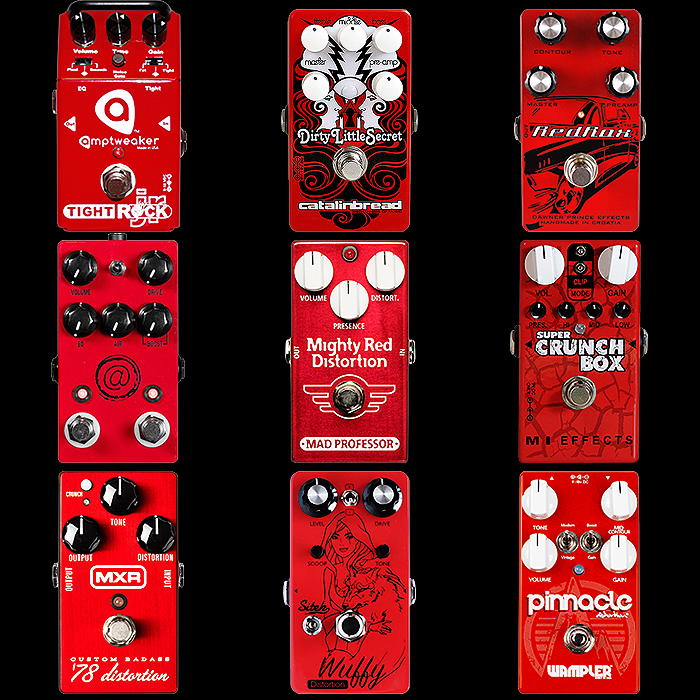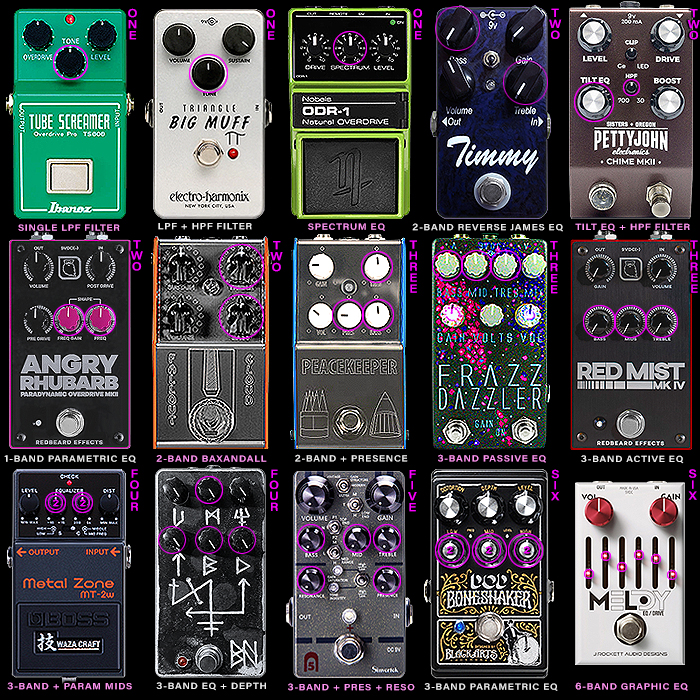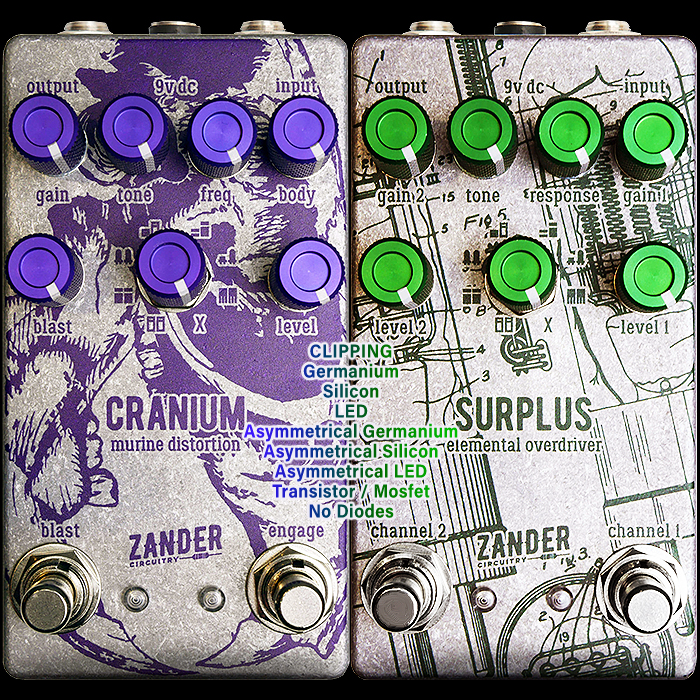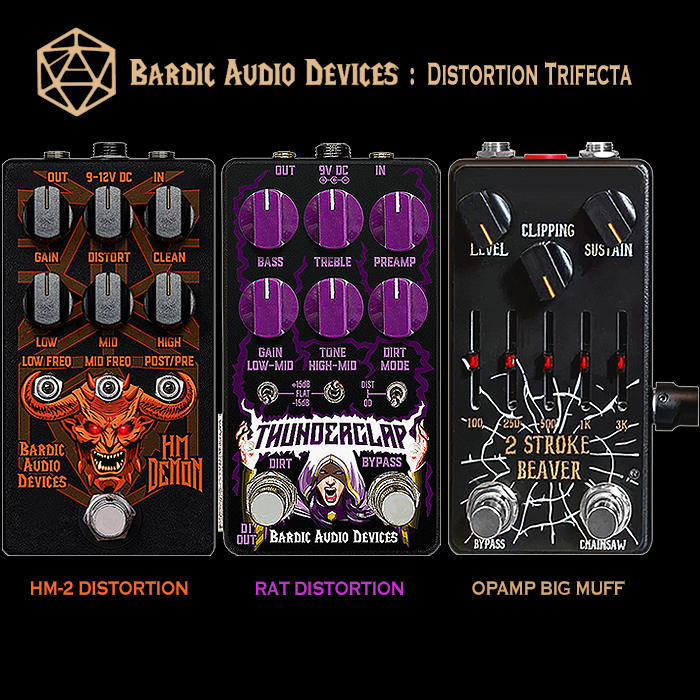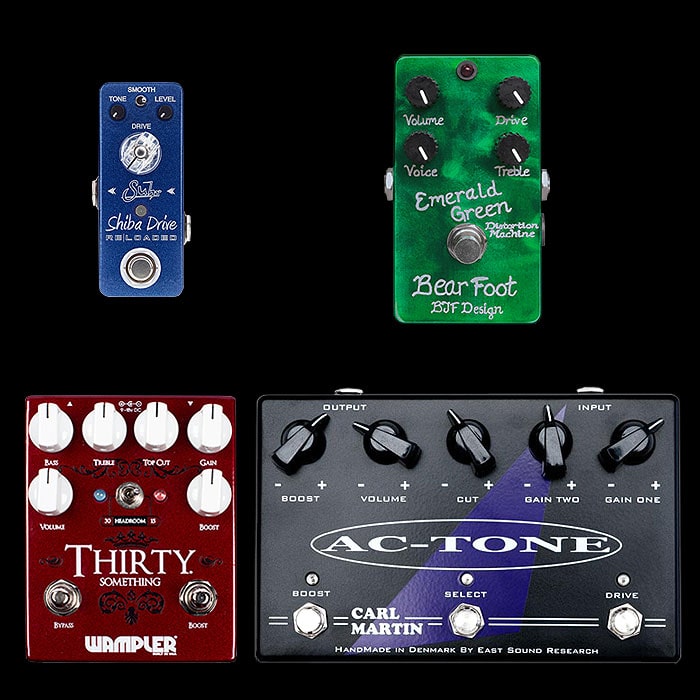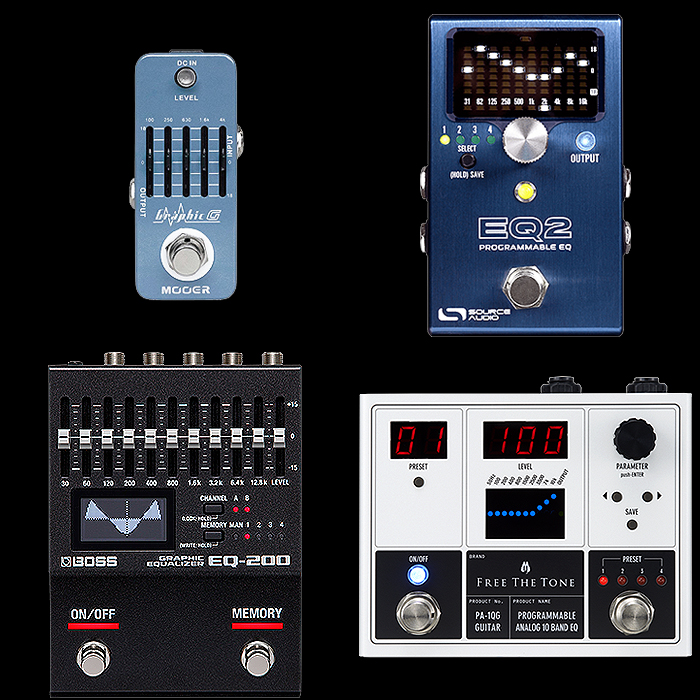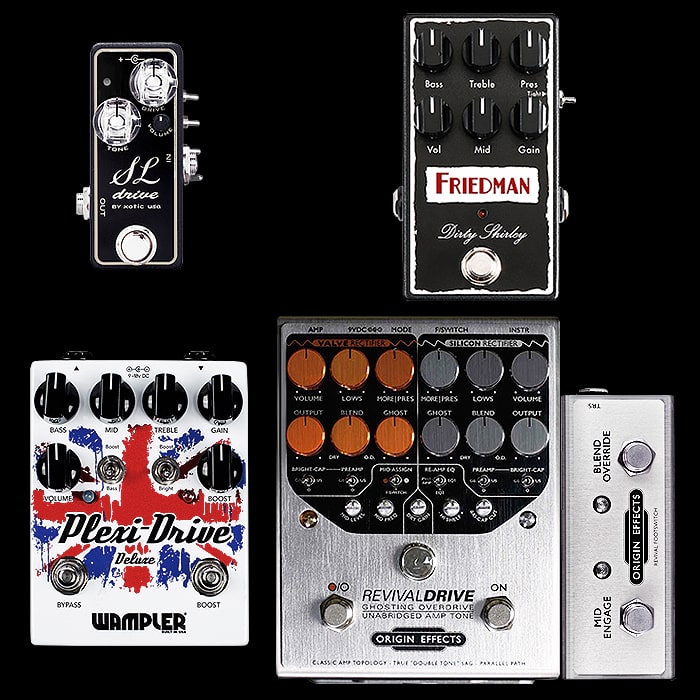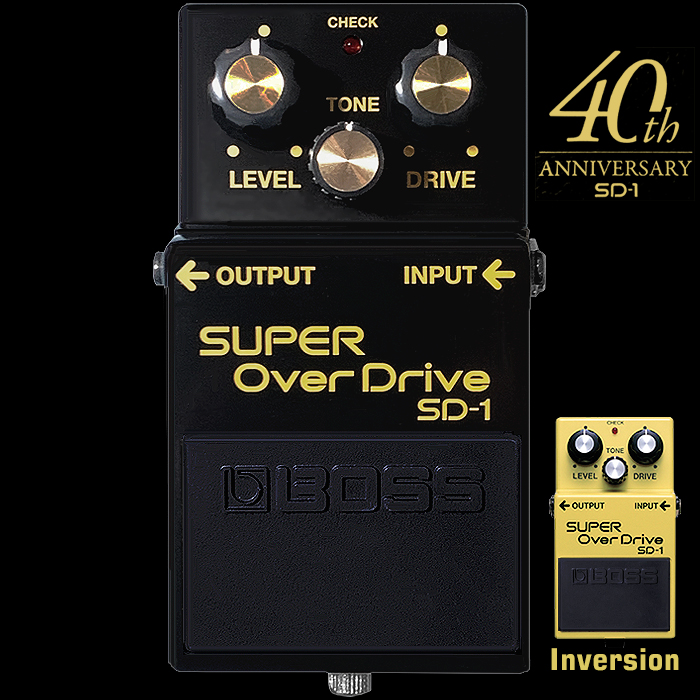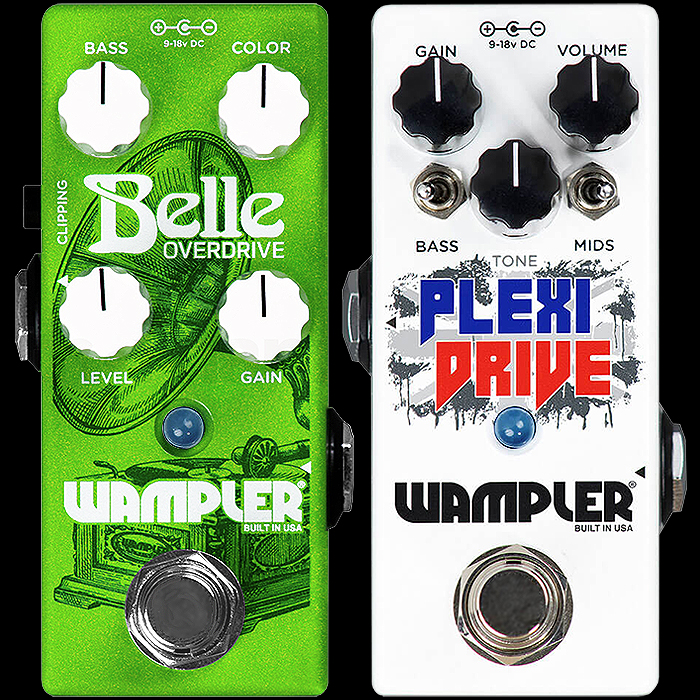12 of the best Pettyjohn Electronics Pedals : Past and Present Day Preferred Range Overview
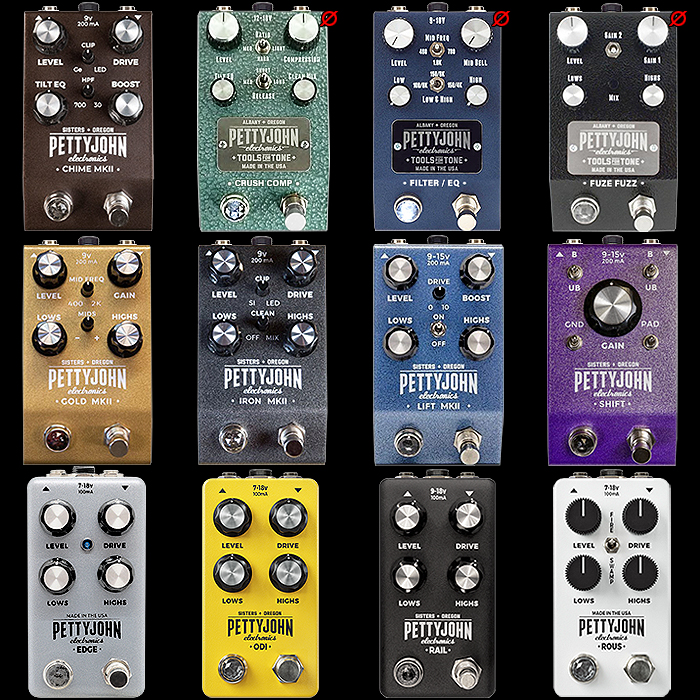
Those more sharp-eyed among you will have noted that I’m currently engaged in exploring the Pettyjohn Electronics range - sort of one or two pedals at a time. And this would seem to be a good point within those proceedings to share some of my findings thus far.
As I’ve relayed elsewhere, I was initially highly confused by Stephen Pettyjohn’s output in that all the Foundry Series pedals were offered with a number of ’Upgrades’. Making it seem to me that the standard versions were somehow subpar - and you needed the upgrades to get the most out of those pedals. I like many I would assume - reasoned that there was something odd going on here with the ’Standard’ / ’Stock’ pedals beings somehow inferior - and I could not understand why Stephen did not make a fully adequate pedal as Standard - which needed no further enhancements?
Of course that was mostly a vocabulary issue really with the word choice, and the language of the website has indeed changed now - and those former ’Upgrades’ are now referred to as ’Mods’ which I feel should really be replaced with the word ’Options’. As typically you get most of those pedals available in sort of 3 variations - with one set of Mods/Options delivering more Headroom and Clarity, another set delivering more Texture and Harmonics, and typically with ’Standard’ / ’Stock’ being the mid-way point between those two extremes. So you can select in effect if you want your pedal to be more Intense or rather more Subtle. I will explain for each pedal as to which ’Options’ / ’Mods’ I went for and why.
The above list features all of the current range, alongside 3 discontinued pedals identified by the ’Ø’ character / symbol - and all appearing in the top row as chance would have it. I’ve taken some artistic licence with those pedals in superimposing their pedal names - in line with the newer variants. Those pedals actually feature no text labels in that area - it’s just a device for visually identifying each of them - Crush Compressor, Filter/EQ, and Fuze Dual Parallel Fuzz/Distortion.
Thus far I’ve acquired 6 of these - actually starting with the Core Series really which seemed to make a lot more sense to me initially - and the first one released in that range - the RAIL (Voltage Rail) Fuzz. Next I did not get the ROUS Rat-style Distortion immediately upon release - as I wasn’t entirely 100% won over by the early sound samples. And it wasn’t really until the YouTube demos arrived a little later - that I was able to ascertain the true prowess of that pedal - which then got snapped up quite quickly.
As is my nature, I always triangulate several video reviews to draw conclusions as to whether a pedal piques my interest sufficiently to acquire it. In this instance I loved everything I saw of the RAIL and ROUS pedals - in fact I thought they sounded fantastic as standard with wonderful rich textures, and required therefore no further modifications in order to be wholly standout representatives of their respective genres. Both of those are incredibly versatile and each has a tonne of sweet-spot tones onboard - formidable as they say in France!
Next came the ODI - which in that format was something I always wanted - an evolved and pimped out Boss OD-1 with Vintage component specs - but no, not with the 14-leg Opamp but rather JRC4558! I determined I wanted the dual JRC4558 Opamp version with the original rare Japanese Silicon 1S1588 Diodes - for maximum vintage texture and harmonics - and it totally lived up to that promise - it sounds really full-on and immense.
Next I had a conversation with Stephen about where in his range I should aim for next. He said that if really pushed, then his 3 own favourite pedals which would always feature on his board and in his go-bag - would be the Chime, Gold, and Lift. Moreover the Chime is the all-time Pettyjohn Bestseller with around 2,000 units sold to-date, including the combination PettyDrives. It was obvious that the Chime should be my next choice, and I was very fortunate that Stephen was already working on another Chime-derived circuit at the same time I was placing my Chime order - in the guise of the Core Edge Overdrive. So I was able to acquire both of those at the same time and reviewed them both together as Sr and Jr versions of essentially the same circuit - but with slightly different parts. Those two are currently my favourite pedals from the range - as we shall see.
I most recently acquired an Iron MKII which is quite a bit mellower than I expected - and that you need to crank on LED setting to get the most texture out of it. It is perfectly described as a Medium Gain Overdrive - while I would further qualify that as a Neutral Medium Gain Overdrive - not meaning transparent here, just that it doesn’t have a particularly strong flavour as such. I believe Stephen engineered it mostly to be a companion pedal - to fill in and enhance frequency ranges in combination with other pedals - and in particular to be deployed alongside the Chime (as seen on the PettyDrive) - to complement that one’s brighter frequency profile. You can get a pretty decent crunch - but it’s slightly softer and mellower compared to something like say an OCD - which obviously clips harder. I will share my settings for each of the pedals as to how I deploy them - when referring to a particular pedal’s details.
So I’m currently up to six so far. In some ways I should have gone for the Gold MKII before the Iron MKII in preference - while I had only relatively recently acquired the Friedman Smallbox Overdrive/Distortion and wanted that to remain in rotation a little longer - before I eventually switch it out for the Gold II.
Where I am currently is that the Gold MKII is my next target - possibly for next month, as May is already pretty hectic. At the same time I’m trying to chase down a reasonably priced version of the now discontinued Fuze Fuzz. Once I’ve added that pair - I will probably deem my Pettyjohn collection suitably fully represented - until another new variety arises.
The 4 pedals in the visual I’ve yet to mention are all favourites of some of my friends and colleagues and still very much in use - which is why those are listed. There’s still quite a lot of love for the Crush Compressor and the Filter/EQ pedal, even tough they are discontinued. And there are a number of fans of the Lift MKII and Shift - for which I personally have other preferences currently. But may still consider if I’m adequately persuaded at some point in time.
I feel that the 8 pedals I will have once I acquire the remaining two targets will represent the range very well. All those Core pedals are particularly excellent and actually really good value for the great tones they have onboard and how easy those are to dial in.
Here follow some more individual details on each of the listed pedals, ordered alphabetically by name as usual :
Chime MKII Bright and Harmonic Vox-style Low Gain Overdrive (Foundry Series) - $299 Standard, Dual Opamp Mod +$100, Max Harmonics Diodes +$50
My version has the Max Harmonics Diode Mod for more texture - to help me get that richer Top-Boosted Vox sound.
Controls : Level, Clip : Ge>LED, Drive, Tilt EQ, High Pass Filter : 700Hz>30kHz, Boost.
Some of you may have noted that I'm a considerable Brian May fan - and I always have one pedal in the chain as my 'Brian May Pedal'. This started with the Catalinbread Galileo, then the Bearfoot FX Emerald Green Distortion Machine, then Menatone Top Boost in a Can, and finally the Chime. And while the Chime doesn't saturate quite as much as say the Emerald Green and TBIAC - I can combine it with the several boosts I have in the chain - as well as the Edge, and Iron MKII to match and surpass those levels. It sounds plenty rich enough on its own too.
Interestingly when you dime the Boost and set the Clipping to the Max Harmonics Diode the output already sounds glorious. Note though that you loose definitions if you dial the Drive much beyond the half-way point - you need to finely adjust that knob to get the maximum texture - which indeed sounds glorious with that Max Harmonic Mod.
Texturally this is currently my favourite Vox-style Pedal - just ahead of the TBIAC and Emerald Green which are both also excellent.
My preferred settings for the Chime are : Level 2 o'c, Clip Full Germanium, Drive 11 o'c, Tilt EQ 11:30 o'c, HPF Full 30kHz, Boost Max!
This is a wonderfully textured pedal and it really sounds glorious in my rig - very smartly engineered controls on the pedal to.
Crush Compressor (Foundry Series) - discontinued - $369 when new
Controls : Level, Ratio : Medium/Hard/Light, Compression, Tilt EQ, Release : Medium/Short/Long, Clean Mix.
A few of my friends still use this fantastic sounding transparent VCA-type compressor with RMS detector circuit for a more natural response to the incoming signal. The VCA Chip is made specially for Pettyjohn to his own specifications for a really musical and complementary sounding Compressor. This is still one of the greats in that genre and well worth getting your hands on - even though the high quality compressor field is heavily contested these days. This has quite a high ticket price comparatively, while it for sure has superior high-fidelity to match that price-point.
Filter / EQ (Foundry Series) - discontinued - $229 when new
Controls : Level, Mid Frequency : 460Hz/1kHz/700Hz, Mid Bell Curve, Low, Low & High Frequencies : 100Hz|8kHz / 150Hz|6kHz / 150Hz / 4kHz, High.
A really cool EQ pedal which several of my readers mention whenever I do a feature on that genre. Obviously features a sort of parametric mids with additional smart frequency selections for both High and Low frequency bands together - on the same rotary control. Again there is no shortage of great EQ pedals out there - parametric, graphic and just straight up potentiometer frequency sweeps. This is nonetheless a great candidate in that area, and well worth seeking out.
Fuze Dual Channel Parallel Blendable Fuzz/Distortion (Foundry Series) - discontinued - $249 when new
Controls : Level, Gain 2 : Low Gain/Medium Gain/Nuke , Gain 1, Lows, Mix : Gain 1 > Gain 2, Highs
I've noted many times on this site how I'm a huge fan of Fuzzy-Drive and Fuzzstortion pedals - and have a sort of capsule collection very specifically of those varieties. This one has been on my wishlist for a while - and long before it got discontinued - while since then I've not encountered one at quite the right price and in the right sort of condition for me. This cleverly features two gain stages where Gain 1 is set via knob, and Gain 2 level is set via 3-way toggle switch. You then use the Mix knob to blend those two gain stages together in parallel for maximum textural and harmonics output. I obviously love fuzzes, and this is one that I really want to add to the collection some day fairly soon. Note that since discontinuation - the various Mods are no longer available - so you will invariably be getting those pedals in Stock configuration.
Gold MKII Marshall/Plexi Style High Gain Overdrive (Foundry Series) - $299 Standard, Dual Opamp Mod +$100, Klon Germanium Diodes Mod +$50
My intended version will have the Russian Klon Germanium Diodes for extra harmonic texture.
Controls : Level, Mid Frequency : 400Hz>2kHz, Gain, Lows, Mids -/+, Highs.
As mentioned previously, this is my next Pettyjohn target, and I've already been persuaded that the best configuration for my preferences is with the Klon Germanium Diodes Mod for maximum texture and harmonics - similar to my Chime variant. The other mod here is obviously more for High Headroom - which is usually the opposite of what I'm after as I really love gain saturation and complex harmonics. All the demos for this pedal are great - and this should do very well as my Plexi-type pedal of choice - also crossing over slightly into JCM800 territory - and can obviously be further juiced with the application of a boost or two. For a Marshall-style pedal this contains the perfect Parametric Mids to get the most out of that circuit. As noted earlier I wanted to give the Friedman Smallbox a further airing - before I bring this one in on rotation in that slot. I already have a lot of commitment for May - so this is likely to happen rather in June - but we'll see how May pans out - that could still be viable - of course depending on all the other moving pieces!
Iron MKII Neutral Medium Gain Overdrive (Foundry Series) - $299 Standard, Dual Opamp Mod +$100, Audiophile Capacitor Mod +$30
My version is wholly Standard - for maximum Harmonics, both Mods for this pedal are really intended for extending the pedal's Clarity and Headroom - so not necessarily to my preferences!
Controls : Level, Clip : Si/LED, Drive, Lows, Clean : Off>Mix, Highs.
I was actually a touch surprised by how mellow this pedal is - and the fact that you need to crank it quite hard to get a reasonable level of crunch. For me the Chime is much higher gain with its Boost maxed out - so it's a little amusing that the Chime is referenced as a Low Gain Overdrive - and this as Medium Gain supposedly with more in the tank - but actually not! As I've noted before - I believe Stephen's approach for this pedal was largely as a combination or companion pedal - designed to fill in the frequency range of other complementary pedals - and in particular the Chime - which sits alongside it on the PettyDrive.
The Iron MKII doesn't have a tonne of strong flavours onboard - it's rather more subtle than that - which is why I refer to is as a somewhat Neutral drive - as there is not a lot of identifiable character here. That said you can calibrate it nicely to achieve a variety of sweet-spot tones - but it does require some patience and some serious cranking of a few of those knobs.
My current preferred settings are : Level at 12 o'c, Clip : Full LED, Drive at Max, Lows at Max, Clean Blend at 9 o'c, and Highs at 4 o'c.
Lift MKII Preamp + Harmonic Overdrive (Foundry Series) - $299 Standard, Soviet Clipping Mod +$50, Orange Drop Cap Mod +$30
Controls : Level, (Harmonic) Drive : 0>10, Boost, Lows, Harmonic Drive : On/Off, Highs.
This Smart Preamp with 2-Band EQ and optional Overdrive voicing is a really clever combination of at least a couple of pedals - and sort of overlaps to some degree with my JA Prism which I deem essential. I may very well try out a Lift in that slot position at some stage - in place of the Prism - while that currently sounds immense in my rig - delivering just the right degree of gooey analog warmth, softness and sustain. I've tried several pedals in place of the Prism - but that somehow just does something magical in my chain and has thus far been impossible to leave out. One of these days I will no doubt get more experimental again - which means I could likely try out the Lift in its place.
Shift 5-in-1 Utility Box (Foundry Series) - $299 Standard, Jensen Nickle Transformer Mod +$60
The Shift has 5 Usage Functions :
- Buffer & boost
- Studio grade direct box
- Tone color box
- Re-amp tool
- Cable extender system
Controls : Output : Balanced/Unbalanced Input : Balanced/Unbalanced Output, Gain : +30dB Clean Boost, Ground Lift, Pad : -20dB Pad
The Shift is a really cool nice-to-have Utility pedal - but one which is currently sort of surplus to my own requirements - I can see though that many would find this a very useful pedal. It's a smart Re-amping Buffer and Boost with some essential control functions for ensuring that your signal fidelity and clarity is optimal. This really is a proper studio tool - and will appeal to those that have the knowledge to deploy it to its maximum capability. A really smart device, but not necessarily one with universal appeal - however worthy it is.
Edge Bright Preamp/Drive (Core Series) - $199 Standard Blue LEDs, Vintage Orange LED Mod +$70, Modern Yellow LED Mod +$80
My Version is the standard Blue LED's Mod with the Highest Headroom vs the Chime, Modern Yellow LED Mod is max texture Chime configuration, and Vintage Orange LED Mod sits in the middle in terms of breakup texture and headroom.
Controls : Level, Drive, Lows, Highs.
And so the first of the Core Series Gørva-enclosured pedals and probably my favourite of the series to date by only the tiniest fraction as the other 3 are truly fantastic also. As mentioned previously, this takes the foundation of the Chime circuit and applies circuit tweaks and different Clipping LED's for more headroom and really nuanced compression - which dances delightfully under your fingers. The playing response to this pedal is so satisfying - and it's warm and smooth and has that lovely bloom I so like. I wend for the Standard / Stock Blue LED version as they deliver the highest headroom and offer the greatest contrast to the Chime. While you can of course alternatively select the same Yellow LEDs as in the Chime - for earlier onset breakup. And then you have the in-between Orange LEDs which render sort of mid-way between the Blue and Yellow LEDs. This is a really great sounding overdrive and does much to restore the reputation of compressed overdrive circuits - beautifully nuanced and dynamic.
My current preferred settings are : Level at 3 o'c, Drive at 12:30, Lows at 1:30, and Highs at circa 12 o'c.
It would be cool to have a deluxe version of this pedal with a 3-way toggle-switch where you could flip between the 3 LED options Blue, Orange and Yellow!
ODI Vintage Style Overdrive (Core Series) - $199 Standard, Classic Opamp Mod +5$0, Transparent Opamp Mod +$50, NOS Diodes Clipping Mod +$80
My Version has both Classic Opamp Mod (Dual JRC4558 Opamps), and NOS 1S1588 Clipping Diodes Mod - for Maximum Vintage Harmonic Texture!
Controls : Level, Drive, Lows, Highs.
This totally lived up to every expectation and I'm so glad I went for both the mods as this pedal sounds immense - lovely vintage textures with rich harmonics. Note that the Level needs to be fairly cranked for my favourite tone to appear - there is a sweet-spot almost at the top of the taper - meaning you crank it right up, and then bring it back a tiny fraction so that extra level of breakup is still audible - sort of 1-2mm back from fully CW!
My preferred settings here are : Level : tiny notch back from Max, Drive at 10 o'c, Lows at 2 o'c, Highs at 1 o'c.
RAIL (Voltage-Rail) Fuzz (Core Series) - $199 Standard, Vintage Orange Drop Caps (Soft+Warm) Mod +$40, Hi-Fi High Headroom Opamp Mod +$50
My version is wholly Standard - I did not feel it needed anything extra as it sounds fantastic at that configuration.
Controls : Level, Drive, Lows, Highs
The 8-notch Drive knob is really the magic ingredient here alongside a really finely calibrated dual-band EQ. If you dial down it opens up the density of the breakup and softens the attack for some great overdrive and fuzzy-drive sounds. Crank the Drive and it gets progressively denser and more textured until at the max 8th notch - where it does something really cool with the bias - to produce the highly textured and gated Infinity voicing. I acquired this at a similar time to the Catalinbread Giygas which I also love - while the RAIL is far easier to dial in - and that Drive knob is so smartly configured to give you so many different sweet-spots right up and down the gain scale. A really innovative fuzz which uses its Voltage Rail to generate the breakup textures - sounds fantastic too.
My preferred setting are : Level at 4 o'c, Drive on notch 2, Lows at 10 o'c, Highs at 2 o'c.
ROUS Rat Style Distortion (Core Series) - $199 Standard, NOS D93 Diodes Swamp Mod +$40, Modern High Headroom Opamp Mod +$50, Inconceivable Mod (Swamp + Modern) +$80
My Version is Standard - I really loved all those Standard edition Youtube demos - and this circuit really has the most amazing sustain by default.
Controls : Level, Drive, Mode : Fire (Silicon Hard-Clipping)/Swamp (Germanium Soft-Clipping), Lows, Highs.
Amazing sustain here as mentioned, with elegant texture lower down the gain scale, and more aggression, texture and density when cranked - not too dissimilar to the dynamics of the RAIL in some ways - while the smooth sustain on the ROUS is really quite exceptional. I was a little slow to warm up to this pedal on first encounter - but it's certainly one of my favourite Rat circuits now - and is one of no less than 25 Rats in my capsule collection.
My preferred settings are : Level 4 o'c, Drive 10 o'c, Clip : Fire, Lows 11 o'c, and Highs at 2 o'c.
Final Thoughts
I know it's part of the branding and promotion too, but these are genuine studio quality tools as befits Stephen's prowess as a top-level Studio Engineer. Everything about his approach is rooted in high-fidelity studio signal processing and utilises the very best parts / components available.
Stephen also recognises that different players have different preferences and requirements - and so he offers his pedals typically in max breakup and texture, or max high headroom Mod editions, and where the Standard / Stock editions are usually the middle point between those two extremes - for a best of both worlds approach also.
Depending on your own preferences - some of these pedals will be optimal in Stock edition, while for others you might benefit from applying a Mod or two.
The Core Series is incredibly easy to get along with and so easy to dial in and achieve superior sounds without any effort. The Foundry Series pedals have a little more about them, and require a little more patience and time-investement on dial-in, but can yield some extraordinary textures if you persevere.
I've mentioned before that Stephen's favourite of his own pedals are the Chime, Gold and Lift. And it is totally understandable why the Chime is the bestseller - I would recommend you start off there if exploring the range - also any of the Core Series too as those are all incredible, and 3 of them I really rate in Standard / Stock configuration.
I love all the Core Series to date, and the Chime and Edge in particular, while the Iron is a little new to me and I will need to let it bed in a while longer before I reach any final conclusions.
I have two more to acquire here - the Fuze and Gold - and I will let you know my experiences of those when I have them.
Of course the whole of the current range is available via the Pettyjohn Webstore. You will need to go direct to Pettyjohn if you are after any of the Mods, while Stock / Standard pedals are in fairly broad distribution, but not so much in the UK any more.
Do you guys have any favourite Pettyjohn Electronics pedals yourselves?







